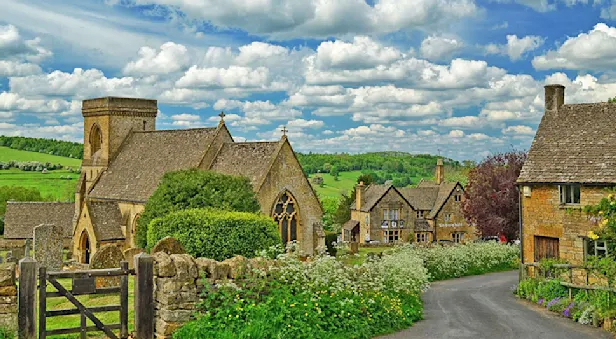Places We Visit in the Cotswolds
Oxford
Oxford is home to the oldest university in England and is the birthplace of Narnia, Hobbits and Alice in Wonderland. CS Lewis spent most of his academic life in Oxford, along with other friends who were also great names in literature, including J.R.R. Tolkien and Lewis Carroll. Once you arrive in Oxford, you’ll understand their inspiration.
It is nicknamed “The City of Dreaming Spires” due to its beautiful skyline of Gothic towers and steeples. Its true name, however, is derived from the old Saxon word “oxenforda.” With the River Thames running through the area, this was an important crossing point for ox carts. Now a perfect mix of ancient and modern, Oxford is also home to some of England’s finest surviving examples of untouched lowland wildflowers and grazing meadows. Some of these meadows even contain traces of Bronze and Iron Age settlements.
Minster Lovell
While this charming riverside village is a destination in itself, most people come here to see the ruins of Minster Lovell Hall. Built in 1435 by the seventh Lord Lovell, it was an upgrade to the property that had been held by the Lovell family since the 12th century. This family and its estate were deeply mired in the politics of the time. Members of the family played roles in the War of the Roses, the Battle of Bosworth and the Lambert Simnel Rebellion. After being convicted of treason as a result of his part in the Battle of Bosworth, the ninth Lord Lovell, Francis, was forced to turn over the lands and the hall to the king. That ended the Lovell connection to this property, and later, the owners dismantled the house, leaving the ruins that can be visited today.
Windrush Valley
Green rolling hills, medieval stone bridges, quiet, idyllic villages seemingly untouched by time—this valley is a picture-perfect example of classic English Cotswold countryside. The Windrush River snakes through the scenic valley, past ancient ruins, Norman churches, Elizabethan manor houses and picturesque cottages, before reaching the River Thames.
Called the Windrush because of how the river winds through the rushes that line the riverbanks, the valley is home to many bird and wildflower species. It is also home to herds of Cotswold Lions, the region’s namesake sheep that have grazed the local pastures for centuries.
Bampton
Bampton is one of the oldest villages in England, dating back possibly as far as the Iron Age. Today, this scenic town is best known as the location for filming most of the outdoor scenes in the PBS series Downton Abbey. While the locals are welcoming to visitors, they are occasionally startled to find tourists walking into their homes or gardens, not quite realizing that Bampton is an actual town with real inhabitants, not simply a set created for the series. After six years of filming in this town, the locals and the TV crew built a bond, and the show’s cast and crew hosted a barbecue for the townsfolk as a parting gift.
Wytham Woods
Wytham Woods covers 1,000 acres and is home to over 500 species of plants and 800 species of butterflies and moths, as well as a large number of badgers and three species of deer. The site contains four important habitats: ancient semi-natural woodland (dating back to the last Ice Age), secondary woodland (dating to the 17th century), modern plantations (from the 1950s and 60s) and limestone grassland. Bequeathed to Oxford University in 1942, this is one of the most researched areas of land in the world, and scientists here have collected valuable bird data for over 60 years (including a breeding study of over 40 generations of great tits), badger data for over 30 years and climate change data for the past 18 years.
Highgrove House
Feel like royalty when visiting the grand residence of the King of England! Built in 1796, this manor is now a favorite home of King Charles and the Queen Consort, Camilla Rosemary Shand. After being purchased by the Duchy of Cornwall in 1980, it was stripped clean and redecorated for its new inhabitants. The on-site Royal Gardens add color and life to the stately home. With years of devotion and attention, the organic gardens are now an esteemed feature of the estate. Environmentally conscious practices (like making their own compost) keep the gardens thriving, thanks to His Royal Highness, who actively manages the gardens.
Westonbirt Arboretum
Westonbirt Arboretum was founded in 1829 by wealthy landowner Robert Holford, who paid plant hunters to bring back rare and exotic species from the farthest corners of the British Empire. He then planted them aesthetically instead of by species or native geographic location. The result is a renowned botanical collection that is famous today not only for its incredible diversity but also for its picturesque beauty.
Covering an area of approximately 600 acres with 17 miles of trails, the arboretum contains 2,500 different tree species from all over the world, with some specimens dating back to the 1850s. Keep an eye out for trees with a blue label; these indicate Westonbirt’s “champion trees,” the tallest or largest (in trunk girth) of their kind in Britain. There are currently 140 champion trees at Westonbirt Arboretum!
Slimbridge Wetland Center
Slimbridge Wetland Center is located in Gloucestershire and is one of the UK's largest wetland reserves. The center is managed by the Wildfowl and Wetlands Trust (WWT), which protects wetlands and the wildlife inhabiting them. Sir Peter Scott, the son of the polar explorer Robert Falcon Scott, founded the WWT. He was also a founding member of World Wildlife Fund and received his knighthood in recognition of his conservation activities.
Slimbridge has the world’s largest collection of captive waterfowl as part of a breeding program, so visitors can count on seeing a wide range of bird species throughout the year. On-site viewing blinds offer excellent viewing of the many species of swans, shovelers, flamingos, ducks and cranes that make the wetlands home.
Painswick Rococo Garden
Rococo gardens are known for their unrestrained exuberance. The Rococo style, whether applied to gardens, home interiors or paintings, is steeped in romance and frivolity. It represents a time of decadence when England’s elite would show off their wealth by hosting parties in gardens such as the one at Painswick. Changing values caused these decadent gardens to fall out of favor. By the 1760s, the Painswick Garden started being cultivated into a more typical—and more restrained—English country-style garden.
Fortunately, in 1748, a painter named Thomas Robins captured the original Painswick Rococo Garden at its peak. This painting became the template for recreating the original Rococo style here, and today, this is the last complete example of a Rococo-style garden in all of England.
Upper and Lower Slaughter
Just one mile apart, these two scenic towns are connected by the shallow River Eye. The slow-moving water through this valley gave these towns their names, which are based on the old Saxon word for “slough.” Both hamlets date back at least to the 10th century and were recorded in the Domesday Book of 1086. This book recorded every landholding in England to allow William the Conqueror to collect taxes.
Upper Slaughter is one of only 14 villages in England that lost no men during either of the world wars, earning it the status of a “doubly thankful” or “double-sainted” town. Lower Slaughter has been home to a manor house since the year 1004 A.D. It was given to the High Sherriff of Gloucestershire in 1611 A.D. His descendants occupied it until it was renovated as a luxury hotel in the 1960s. Apart from renovations like this, no new construction has happened in either of the Slaughters since 1906.
Stow-on-the-Wold
At 800 feet above sea level, Stow-on-the-Wold is the highest town in the Cotswolds. True to its “wold” moniker, it sits atop a hill and experiences winds and cooler weather due to its altitude. The town was initially called Edwardstow after Saint Edward, the town’s patron. King Henry II granted the town a charter in 1107 A.D., beginning its long-lasting market tradition. He changed its name to Stow-on-the-Wold; “Stow” is an Old English word meaning place or locality.
The centrally located Market Square, which signifies the town’s importance as a wool-trading center during the Middle Ages, is the town’s main attraction. It hosted a vibrant market every Thursday from 1107 A.D. to around 1900 A.D. Today, surrounded by shops, restaurants, cafes, antique stores, houses and inns, all built in the honey-hued local stone, the square remains the focus of life for residents. The 800-year-old market tradition continues during the farmers market on the second Thursday of each month.
In 1330 A.D., King Edward III allowed the town to hold an annual week-long summer gathering called the Stow Fair in the Market Square. The fair became the largest in the country, seeing the sale and trade of thousands of sheep daily during the height of the Cotswolds’ wool industry. Walking through the streets, you will notice the narrow and winding alleyways, a strategic design choice made to herd sheep into the square. During the 15th century, the Stow Fair was split into two 5-day fairs in May and October. After the wool trade declined, people began to trade horses. The market tradition continues with the Gypsy Horse Fair twice a year, with hundreds of horses for sale, riding shows and performances.
St Edward’s Church is another highlight near the Market Square, with its whimsical ‘Tolkienesque’ North Door flanked by ancient yew trees. It’s speculated that this arched door is the inspiration behind the “Doors of Durin” in the Lord of the Rings series.
Broadway
Shed the crowds by walking from the Broadway Tower hill into the scenic village of Broadway. We are likely to see far more sheep than people along the way, and there is a high likelihood of young lambs as well. We will also learn about this region's changing attitudes toward pheasant hunting. For decades, farmers here have partially supported themselves by raising pheasants and charging hunters from the city for the opportunity to hunt them. As hunting is falling out of favor, this is no longer a reliable source of income.
The village itself is known as the “Jewel of the Cotswolds.” Although modest in size overall, the hamlet is named after the broad, tree-lined roadway through the center of town that once served as an important connecting link between Worcester and London through Wales.
Hidcote Manor Garden
After his mother bought the 300-acre plot in 1907, the talented American horticulturist Major Lawrence Johnston created Hidcote Manor Garden. This must-see National Trust property has become famous for its collection of rare and exotic plants, shrubs and trees. Johnston hunted down these curated specimens in his travels to far-flung locations. In 1948, the site was the first of many significant gardens acquired by the National Trust under its Gardens Fund.
Today, gardeners flock from around the world to get a glimpse of this influential Arts and Crafts garden. Arranged as separate “rooms,” each area of the garden is distinct, peaking with color at different times of the year. Water features abound, creating an even more peaceful and calm atmosphere. There’s mystery here too. None of the plants are labeled, although if something catches your eye, the National Trust representatives are more than happy to tell you about it.
Join these European Nature Adventures

The Cotswolds: Exploring English Nature
Wander ancient beech forests and wildflower meadows, follow hedgerows and trout-filled streams, tour private gardens and meet artisan food producers, in an idyllic landscape with a focus on native habitats and conservation.



































